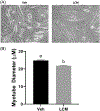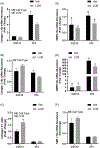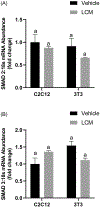Development of skeletal muscle fibrosis in a rodent model of cancer cachexia
- PMID: 37150891
- PMCID: PMC10330674
- DOI: 10.1002/cbf.3797
Development of skeletal muscle fibrosis in a rodent model of cancer cachexia
Abstract
Cachexia is characterized by losses in lean body mass and its progression results in worsened quality of life and exacerbated outcomes in cancer patients. However, the role and impact of fibrosis during the early stages and development of cachexia in under-investigated. The purpose of this study was to determine if fibrosis occurs during cachexia development, and to evaluate this in both sexes. Female and male C57BL6/J mice were injected with phosphate-buffered saline or Lewis Lung Carcinoma (LLC) at 8-week of age, and tumors were allowed to develop for 1, 2, 3, or 4 weeks. 3wk and 4wk female tumor-bearing mice displayed a dichotomy in tumor growth and were reassigned to high tumor (HT) and low tumor (LT) groups. In vitro analyses were also performed on cocultured C2C12 and 3T3 cells exposed to LLC conditioned media. Immunohistochemistry and quantitative polymerase chain reaction (qPCR) analysis were used to investigate fibrosis and fibrosis-related signaling in skeletal muscle. Collagen deposition in skeletal muscle was increased in the 1wk, LT, and HT groups in female mice. However, collagen deposition was only increased in the 4wk group in male mice. In general, female mice displayed earlier alterations in extracellular matrix (ECM)-related genes beginning at 1wk post-LLC injection. Whereas this was not seen in males. While overall tumor burden is tightly correlated to cachexia development in both sexes, fibrotic development is not. Male mice did not exhibit early-stage alterations in ECM-related genes contrary to what was noted in female mice.
Keywords: biological sex; cancer cachexia; extracellular matrix; fibrosis; muscle wasting.
© 2023 John Wiley & Sons Ltd.
Conflict of interest statement
CONFLICT OF INTEREST STATEMENT
The authors declare no conflicts of interest.
Figures







References
-
- Tisdale MJ. Mechanisms of cancer cachexia. Physiol Rev. 2009;89:381–410. - PubMed
-
- Argilés JM, Busquets S, Stemmler B, López-Soriano FJ. Cancer cachexia: understanding the molecular basis. Nat Rev Cancer. 2014;14:754–762. - PubMed
-
- Sadeghi M, Keshavarz-Fathi M, Baracos V, Arends J, Mahmoudi M, Rezaei N. Cancer cachexia: diagnosis, assessment, and treatment. Crit Rev Oncol Hematol. 2018;127:91–104. - PubMed
MeSH terms
Grants and funding
LinkOut - more resources
Full Text Sources

